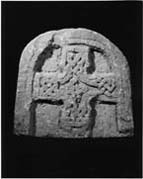Select a site alphabetically from the choices shown in the box below. Alternatively, browse sculptural examples using the Forward/Back buttons.
Chapters for this volume, along with copies of original in-text images, are available here.
Object type: Round-headed grave-marker
Measurements: H.33.6 cm (13 in); W. 38.1 > 33 cm (15 > 13 in); D. 14 cm (5.5 in)
Stone type: Coarse-grained, massive yellow sandstone
Plate numbers in printed volume: Pl. 14.57-60
Corpus volume reference: Vol 1 p. 46-47
(There may be more views or larger images available for this item. Click on the thumbnail image to view.)
A (broad): A cross in relief is set in a broad flat-band frame with a wavering grooved inner moulding. The cross is type A11. Its shape is outlined by a narrow flat-band moulding enclosing interlace in the arms and a knot in the centre. The interlace is muddled and is produced by splitting the two strands which link round the centre into four strands, as they enter the arm. There are clear pick- or punch-marks round the cross.
B, D and E (narrow sides and top): A continuous nine-element ring-twist set in a flat-band moulding.
C (broad): Roughed out with a cross but unfinished(?).
These cross-decorated grave-markers were popular in the late Saxon period (Introduction, p. 8). The carving is deeper than, for example, Bothal 6, but the carver is not competent to produce complex interlace.



